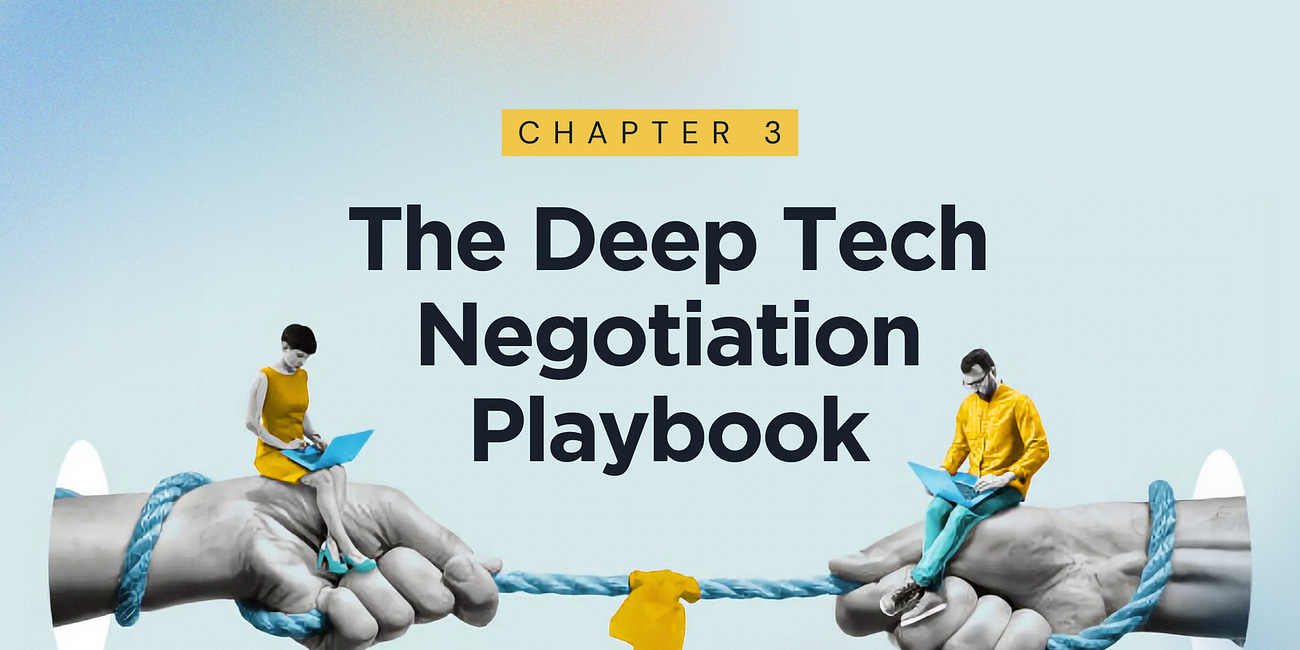⚛️ Italy Bets Big on Nuclear; 🧠 OpenAI Nears $300B Val.; ♻️ Waste as Carbon Sink; 🤖 Robotics Scales Food Automation; ☢️ Nuclear is now “clean energy” in Colorado & More | Deep Tech Briefing #55
Weekly Intelligence on Deep Tech Startups and Venture Capital.
Thanks for reading Deep Tech Briefing, our weekly intelligence on deep tech startups and venture capital. If you like what you see, I encourage you to subscribe to all our pieces here.
Before Go Ahead:
Deep Tech Briefing is just one part of The Scenarionist experience. To enjoy the full experience, become a Premium Member!
The Scenarionist Premium is designed to make you a better Deep Tech Founder, Investor, and Operator. Premium members gain exclusive access to unique insights, analysis, and Venture Guides with the wisdom of the world’s leading Deep Tech thought leaders. Invest in yourself, and upgrade today!
Dear Friends,
It only lasted thirty seconds. A small European rocket rose from the icy tundra of northern Norway, arched briefly into the sky—and then failed. Its engines cut. The vehicle lost control. It fell back to Earth and exploded into the Arctic sea.
No payloads were lost. No one was hurt. But something else may have shifted: Europe’s posture toward sovereign launch capabilities.
To the casual observer, this was a failed test flight. But in deep tech, these short, silent moments can matter more than a hundred product demos. They’re not just about hardware. They’re about readiness—industrial, financial, geopolitical. And increasingly, the question isn’t if we can build breakthrough systems. It’s how fast we can scale them, and who controls the ramp.
Across the frontier, that same pressure is mounting. Automation isn’t just replacing workers—it’s replacing entire workflows. This week alone, robots in refrigerated food plants are replacing manual assembly lines, AI-powered tractors are enabling 24/7 farming, and waste-to-energy plants in Northern Europe are being refitted as carbon sinks. These are not science projects. They are production-scale deployments backed by institutional capital—and a deepening urgency to build resilience across core systems.
One clear example: nuclear energy.
For years, the debate around nuclear has been stuck in a binary—either utopian salvation or catastrophic risk. But something has shifted. In Italy, a four-decade moratorium has quietly ended, with hundreds of millions in public funds being steered toward next-generation nuclear systems. In Colorado, nuclear is now legally categorized as “clean energy,” opening access to state-level incentives once reserved for wind and solar. In Texas, industrial sites are preparing for advanced reactor deployments to power heavy industry directly.
This isn’t just about sentiment. It’s about frameworks. And frameworks shape capital.
Investors are watching closely. The reclassification of nuclear as “clean” may sound symbolic, but it changes how funds are allocated, how incentives are triggered, and how risk is priced. And when paired with scalable, modular technologies—many of which have been quietly maturing in the background—nuclear begins to look less like a legacy industry and more like an industrial strategy.
And this is the real thread running through this week’s briefing: strategy over hype.
In the U.S., a battery startup is moving beyond R&D into vertically integrated recycling and manufacturing. In the Netherlands, chemical recycling is being scaled into a major port zone, signaling a shift away from pilot-scale thinking. In orbit, autonomous satellite infrastructure is being prototyped—offloading decisions from ground stations to edge compute. Meanwhile, OpenAI is reportedly raising $40 billion to fund a future where foundational AI doesn’t just scale—but runs on new kinds of infrastructure.
That last part is critical. Because the world of deep tech isn’t a linear upgrade from the systems we already have. It’s a discontinuity. And discontinuities create new terrain—new power centers, new vulnerabilities, new winners.
When capital flows into deep tech, it’s not chasing the next app. It’s chasing infrastructure.
And infrastructure requires different questions—about timelines, supply chains, policy alignment, and manufacturing readiness. What seems like a niche hardware failure in Norway is actually a macro signal about Europe’s launch capacity. What looks like a retrofitted trash incinerator is actually a carbon sink that could scale to 500 cities. What sounds like a boring agtech partnership is actually an attempt to sequence biology at industrial scale.
In other words: the edge is shifting. And for founders and investors alike, staying ahead means learning to read the deeper signals beneath the headlines.
That’s where we go every week—into the less obvious, the technically dense, the geopolitically charged. Sometimes it’s hardware. Sometimes it’s policy. Sometimes it’s a breakthrough or a talent shift.
Stay with us to stay ahead of what truly matters!
Enjoy the read!
✨ For more, see Membership | Venture Guides | Insights | Deep Tech Catalyst
In Today’s Briefing
The Big Idea – Europe’s first orbital launch attempt by a private operator ends in failure—but signals something bigger.
The Key Updates – Italy moves to reintroduce nuclear energy with a public investment plan focused on advanced reactors. In the U.S., robotics is gaining ground in agriculture and food processing, while chemical recycling and urban-scale carbon capture projects are beginning to scale. Meanwhile, AI infrastructure is expanding rapidly to meet growing demand for large-scale generative models and autonomous systems.
Breakthroughs and Discoveries – Innovations in battery chemistry, photonic interconnects, and bidirectional charging point to a new generation of infrastructure technologies. From sodium-iron storage to AI-enhanced maintenance systems, deep tech is increasingly focused on scalable, system-level impact.
Deep Tech Power Plays – The UK doubles down on fusion energy and foodtech regulation, while Colorado reclassifies nuclear power as clean energy.
Interesting Reading:
The deeper you dig, the weirder, wider, and more telling the world of deep tech becomes. Here are a few standout reads from this week:
LPs still cautious as VC fundraising remains tough – Limited partners aren’t loosening their grip just yet, and that’s reshaping the pace of innovation across Europe. Sifted
Federal funding cuts could destroy lab-grown startups – Cultivated meat and bio-startups are running out of time—and money. PitchBook
China’s EV battery titan is expanding in Europe as Northvolt teeters – CATL tightens its grip on the global battery race as a European competitor falters. Business Insider
Israel Expands Investment in AI Border Control Systems – Where geopolitics meets edge-AI: Israel doubles down on autonomous defense at its borders. iHLS
Battery materials face a rocky path – The battery boom is real, but the supply chain behind it may be built on shaky ground. C&EN
Opinion: It’s time for patents to serve the common good – A bold proposal to reframe IP not just as protection, but as progress. C&EN
US Excludes Steel, Aluminum, Copper, Gold From Reciprocal Tariff – A curious carve-out that hints at deeper industrial dependencies. Bloomberg
Cambridge and Oxford lead UK cities for VC funding – The UK’s intellectual capitals are quietly becoming capital magnets. PitchBook
Global Counterspace Capabilities: An Open Source Assessment – A sobering look at the global arms race above the atmosphere. Secure World Foundation
Carbon Capture Politics Are Coming for DeSantis – In Florida, climate tech gets tangled in red-state politics. Heatmap News
State legislation: Texas considers $2B incentive fund to attract new nuclear projects – Lone Star State thinks nuclear—and puts big money on the table. ANS News
Roomba Creator Says Humanoid Robots Are Overhyped – From someone who actually builds robots, a sobering take on the humanoid hype train. The Information
The Deep Tech Negotiation Playbook | Chapter 3/4
Chapter 3 of The Deep Tech Negotiation Playbook just dropped!!
If you've ever tried to negotiate an investment or partnership in deep tech, you know it hits different. Long cycles. Big uncertainty. Massive upside. And a whole lot of room for misalignment if you don’t play it right.
The first two chapters of this series helped you understand the two sides of the table: the founder, holding a hypothesis and a dream; and the investor, holding capital and looking for signals of exponential return.
Then we looked at the levers you have at your disposal—market, technology, team—and how to turn those assets into a tactical advantage.
But here, in Chapter Three, the tone changes. This isn’t about potential anymore. This is about power.
Because when you raise money, what you’re actually offering isn’t your science. It’s not even your product—or more precisely, it’s not your tech product.
It’s ownership
The Big Idea:
A Short Flight, A Long Game: What Isar Aerospace’s Test Tells Us About Europe’s Launch Market
On March 30th, under the frozen sky of Norway’s Andøya Spaceport, a 28-meter rocket rose slowly from the launchpad, marking a historic first: the maiden orbital launch attempt from European soil by a commercial company. Thirty seconds later, the Spectrum rocket, built by Munich-based Isar Aerospace, lost control, its engines shut down, and the vehicle fell back to Earth, exploding in a remote patch of Arctic sea.
No payloads were onboard. This was a test flight. And while the outcome was visually dramatic, the implications are more structural than spectacular. For Europe’s nascent launch sector—still operating in the shadow of SpaceX—this short flight is part of a longer strategic equation.
Founded in 2018, Isar Aerospace is among the most well-capitalized space startups in Europe, with over €430 million in funding and backers including the NATO Innovation Fund.






